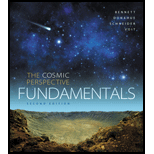
Explain all answers clearly, with complete sentences and proper essay structure if needed. An asterisk (*) designates a quantitative problem, for which you should show all your work.
Adding Up Asteroids. It’s estimated that there are a million asteroids measuring 1 kilometer across or larger. If a million such asteroids were combined into one object, how big would it be? Compare your answer to the size of Earth. (Hint: Assume that each asteroid is a sphere with a radius of 0.km; the volume of a sphere is
Want to see the full answer?
Check out a sample textbook solution
Chapter 6 Solutions
The Cosmic Perspective Fundamentals (2nd Edition)
Additional Science Textbook Solutions
Physics for Scientists and Engineers: A Strategic Approach with Modern Physics (4th Edition)
University Physics (14th Edition)
Tutorials in Introductory Physics
The Cosmic Perspective (8th Edition)
Introduction to Electrodynamics
Conceptual Physical Science (6th Edition)
- Read the following items carefully. State your assumptions if any. Show your COMPLETE solution and BOX your final answers. Keep your answers and solutions in 4 decimal places. > Initially, 100 milligrams of a new radioactive substance Tobium, named after its discoverer Sir Tobs, was discovered and collected from one of the moons of Jupiter. After 6 hours from collection, the mass decreased by 4%, If the rate of decay IS proportional to the amount of the substance present at time t, find the amount of Tobium remaining after 48 hours.arrow_forwardAssume that there are a million asteroids 1 kilometer across or larger in the asteroid belt. For both questions, assume that all the asteroids are perfectly spherical. I a. If a million asteroids 1-kilometer across were all combined into one spherical object, how big would it be across? b. How many 1-kilometer diameter asteroids would it take to make an object as large as the Earth?arrow_forwardSee the screenshot uploaded. Answer in a step-by-step format, add diagrams, and detailed side notes for a better understanding. For a more clear response please answer on paper Thank you!arrow_forward
- Question Completion QUESTION 11 Consider two vectors and shown in the figure below. A The vector subtraction- A-B is best illustrated by OA. O B. Save and Submit to save and submit. Click Save All Answers to save all answers.arrow_forward* Question Completion Status: Consider two vectors and shown in the figure below. The vector sum is best illustrated by A+B OA. OB. Click Save and Submit to save and submit. Click Save All Answers to save all answers. O Type here to search TAarrow_forwardvork Assignment Be sure to answer all parts. A small hole in the wing of a space shuttle requires a 16.0 cm² patch. (a) What is the patch's area in square kilometers (km²)? Enter your answer in scientific notation. x 10 km2 of the patch to the nearest cent? (b) If the patching material costs NASA $4.45/in², what is thearrow_forward
- PROBLEM SOLVING: Express your answer to the fourth decimal places. Show complete solution. Box your final answer. 1. A wooden object found in an Indian burial ground and subjected to radiocarbon dating. The decay rate associated with C-14 is 10 disintegrations per minute per gram carbon. What is the gge of the obiect?arrow_forwardWrite a CR for the solved problem. A example of one is attached as well. The problem about the ROCK is the example CR. The problem you ARE writing a CR for is 5x^2-8x=3. Instructions below. For the CR's, claim you should answer the question of , do you get 2 real solutions, 1 real solution, or 2 complex solutions? For your reasoning you should explain how you know. Use the example attached to help you answer. hints: that plus minus sign means there are two answers. If the number under the square root is positive, you have two real solutions. If the number is negative you have two complex solutions. If the number is 0 under the square root you have 1 real number solution.arrow_forwardShow your complete, clear and detailed solution. Please explain also how did you get your answer. Thank you.arrow_forward
- What is the gravitational force between two asteroids? The mass of the first asteroid is 2,040,000. kg. The second has a mass of 670,000,000 kg. The distance between them is 450 miles. Show the formula you are using, and your work.arrow_forwardDirections: Use GRESA method. note: please thoroughly explain your answer and do not forget to follow the GRESA (Given, Required, Equation, Solution, Answer)! thank you solve LAST three subparts ill give thumbs uparrow_forwardbox the finals answers. Provide the necessary explanations for your solutions. Show the necessary diagrams.arrow_forward
